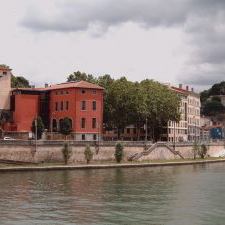 Several years ago, when I told my mom that I would spend a year studying abroad in Lyon, France, she had had just one question. “Why on earth would you choose Lyon?”
Several years ago, when I told my mom that I would spend a year studying abroad in Lyon, France, she had had just one question. “Why on earth would you choose Lyon?”
With the romantic cityscape of Paris and the sun always shining on the south coast of France, why choose to live in a city that as long been viewed as the dirty, industrial capital of France?
One reason: I wanted to live in a place that had me asking, “Where are the tourists?” not “Where are the locals?”
Lyon, the second-largest city in France, houses an incredible amount of restaurants, historic sites and—get this—friendly people. But, the average tourist typically regards Lyon as a stopover city. Nothing more than a night or two on the itinerary; the ideal place to rest their weary legs in between the Riviera and Paris.
If you are interested in Paris travel, don’t miss our Off the Brochure Travel Guide: Paris, France. Or learn about the Secret Spots of Paris.
At most, they aimlessly walk the streets of Vieux Lyon, hoping to fall into one of the city’s famed dinner menus. They miss the crowded back alleys and the sunny summer days down by the river, the very thing they are striving to experience in Paris or Nice.
And because it isn’t a huge tourist destination (although that has been changing over the years), most guidebooks seem to only skim the surface. So the question remains, where does the serious traveler go to truly discover and experience one of the coolest cities in France?
Getting Around
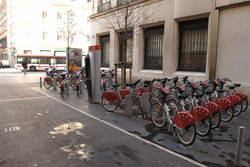 The entire city is made accessible by one of Europe’s best public transportation systems: rental bikes. Velo’v (www.velov.grandlyon.com), the local rental bike outfit, has 340 stations with more than 400 bicycles. After purchasing a rental card at the Lyon tourist office, simply go to one of the bike rental kiosks and off you go.
The entire city is made accessible by one of Europe’s best public transportation systems: rental bikes. Velo’v (www.velov.grandlyon.com), the local rental bike outfit, has 340 stations with more than 400 bicycles. After purchasing a rental card at the Lyon tourist office, simply go to one of the bike rental kiosks and off you go.
It’s even possible to take a ride to anywhere in the city and drop off the bike at a different location. Just remember that bike stations will be full at certain hours—for example, stalls tend to fill up on Friday evenings. But, if you plan your trip away from the crowds, you should be fine.
Two Rivers, Two Hills and a Peninsula
Lyon is the capital of the Rhone-Alpes region, one of France’s 26 regions. It is located in the south-central and eastern parts of the country, bordering Switzerland to the east. The Rhone-Alpes region is also home to Mt. Blanc and a sizable portion of the French Alps, which allows for easy access from Lyon to some of the premiere winter ski resorts (about two hours by train).
For more unique travel experience in France, check out Touring France and the Tour de France.
Geographically, Lyon is situated at the point where two rivers, the Roane and the Soane, join. The two rivers played an important historical role and continued to be celebrated today, as it seems like a majority of Lyon’s hot spots and sites are close to either the Roane or the Soane.
Vieux Lyon (old Lyon), sits on the west bank of the Soane and is the old center of the city. If you run into a tourist anywhere in Lyon, it will be in Vieux Lyon. That’s not to say it should be avoided, but expect to see clusters of foreigners and overpriced venues.
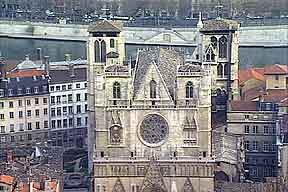 Get off at the Vieux Lyon Metro stop (the D metro line) and walk towards the Primatiale St. John, one of the oldest churches in Lyon. Notice the decapitated heads on church fixtures that were cut off during the Nazi occupation of France and continue down Rue du St. Jean, passing the boutique-y shops and touristy restaurants.
Get off at the Vieux Lyon Metro stop (the D metro line) and walk towards the Primatiale St. John, one of the oldest churches in Lyon. Notice the decapitated heads on church fixtures that were cut off during the Nazi occupation of France and continue down Rue du St. Jean, passing the boutique-y shops and touristy restaurants.
Continue down this road for awhile, until the Soane River appears on your left. Keep walking to the Soane and continue up the west bank of the river on the paved footpath. The path is full of commuting workers and children walking home from schools; the further north you head, the more entrenched you become in local Lyon surroundings.
If you’re up for a longer walk, stroll up the path until you encounter Ille Barbe, an island that was once home to a 5th-century monastery. It’s about a 4-mile walk to Ille Barbe from Viuex Lyon, but the beautiful river path makes the experience well worth it.
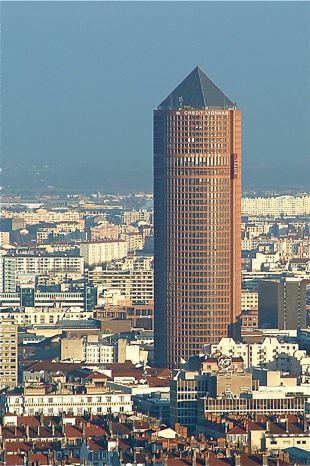 Two hills, Fourviere and Croix-Rousse, loom over the rivers and city center. Roman ruins and the immense basilica of Notre-Damn de Fourviere rest on top of Fourviere, which is the vastly more popular of the two hills. But, while Fourviere provides awesome views of the city below (look for the Credit Lyonnaise tower, which locals call le crayon–“the pencil”), don’t miss the ride up Croix-Rousse to discover some true local gems.
Two hills, Fourviere and Croix-Rousse, loom over the rivers and city center. Roman ruins and the immense basilica of Notre-Damn de Fourviere rest on top of Fourviere, which is the vastly more popular of the two hills. But, while Fourviere provides awesome views of the city below (look for the Credit Lyonnaise tower, which locals call le crayon–“the pencil”), don’t miss the ride up Croix-Rousse to discover some true local gems.
Known as the “hill that works,” Croix-Rousse is a maze of apartment-lined streets, fine restaurants, and steep steps. Every morning except for Monday, the open-air market, Marche de la Croix-Rousse, opens on the Boulevard de la Croix-Rousse. Here is where you’ll see locals bartering with farmers and vendors, trying to get the cheapest organic, homegrown produce.
Just take the C metro line to the Croix-Rousse stop, peruse the market, and walk down the switchback roads back towards the center of town. A bonus: around the winter holidays, the Croix-Rousse market turns into a full-time Christmas bazaar. Brush up on your French and get ready to barter!
Want more insider advice on France travel? Try Suzy Gershman’s Postcard from Paris: Winter Sales, Hotel Deals and Fashion Trends.
The point where the two rivers meet creates a peninsula where the city center of Lyon lies. A little ways up from the southern tip of this peninsula acts the heart of the “new city,” which is a great contrast from historical Viuex Lyon across the Soane.
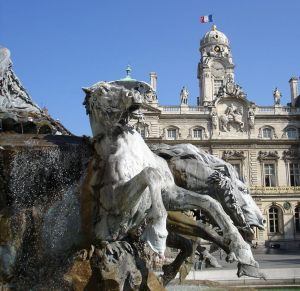 Walk from the train station at Perrache up Rue de Victor Hugo and stop at Place Bellecour. Take a ride on the huge Ferris wheel in the center of the plaza for great views, or, if it is winter time, rent some ice skates and glide around the makeshift ice rink installed in the center of the plaza.
Walk from the train station at Perrache up Rue de Victor Hugo and stop at Place Bellecour. Take a ride on the huge Ferris wheel in the center of the plaza for great views, or, if it is winter time, rent some ice skates and glide around the makeshift ice rink installed in the center of the plaza.
Then walk up Rue de la Republique, past a busy McDonald’s, and continue down Rue de la Republique until the pedestrian-only street comes to a T-intersection.
On your right is Hotel de Ville, which is usually too overcrowded with skateboarders and soccer players to truly relax and people watch, so take a left at into Place des Terraux. Here, there are several cafes lining the road, perfect to grab a drink and watch the bizarre fountains that flow from the center of the square during the summertime.
Manger, boire and party!
French culture report: Will Topless Tanning Become a Relic of France’s Past?
Many guidebooks are quick to point out Lyon is a culinary capital in France. That’s in part because Lyon’s geographic location lends itself as a meeting place for all styles of French cuisine, which has developed into uniquely authentic Lyonnaise cuisine.
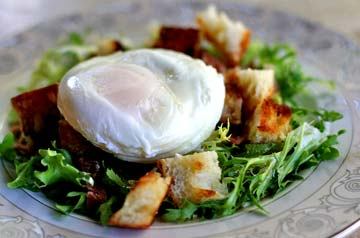 For example, you can’t have an authentic Lyon experience without sampling a salade Lyonaisse, a salad of lettuce, bacon, croutons, poached egg, and Dijon vinaigrette. This dish is so local to the city that most restaurants will serve it at the beginning of a meal.
For example, you can’t have an authentic Lyon experience without sampling a salade Lyonaisse, a salad of lettuce, bacon, croutons, poached egg, and Dijon vinaigrette. This dish is so local to the city that most restaurants will serve it at the beginning of a meal.
It is impossible to pick just one or two restaurants that exemplify traditional Lyonaisse cuisine, but there are some hints that one can heed when deciding where to eat. First, stay away from Vieux Lyon. The area has decent food but is generally overpriced and lacking in local atmosphere. Second, instead of hunting and picking items off the à la carte menu, choose from the restaurant’s menu of the day, which generally reflect the chef’s preparations based on the freshest and most seasonal ingredients available that day.
If you’re a foodie, too, check out Voyage de Fromage: Destinations for Cheese-Lovers.
Lyon is surrounded by some of the greatest wine growing country in the world. There are several different wine country tours leaving from local hotels. But if you want to do as the locals do, skip the group tours and go on your own. For an easy introduction, visit the “wine park,” created by leading wine merchant George Deboueuf, aka “King of the Beaujolais” who is credited for introducing Beaujolais to the rest of the world. Hameau du Vin (www.hameauduvin.com) is part winery, part restaurant, part garden and part museum, ideal for an afternoon wine experience.
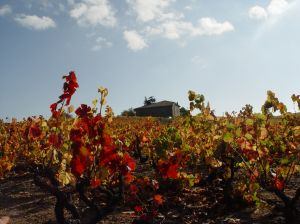 On the third Thursday of November is the Beaujol’ympiades festival, celebrating the arrival of the Beaujolais Nouveau. Beaujolais Nouveau is a special blend of wine that doesn’t increase in flavor with age, so it is best to drink the wine as close to that day as possible. Live music and dancing starts around 9 p.m. in Place Anonin Poncet, followed by samples of the new wine being passed around the square. The night can take many different directions from there, but don’t forget to bring home a bottle or two before it’s all sold out.
On the third Thursday of November is the Beaujol’ympiades festival, celebrating the arrival of the Beaujolais Nouveau. Beaujolais Nouveau is a special blend of wine that doesn’t increase in flavor with age, so it is best to drink the wine as close to that day as possible. Live music and dancing starts around 9 p.m. in Place Anonin Poncet, followed by samples of the new wine being passed around the square. The night can take many different directions from there, but don’t forget to bring home a bottle or two before it’s all sold out.
Another little-known festival in Lyon that appeals to a different sense: sound. Le Nuits Sonores (www.nuits-sonores.com) is an electronic and indie music festival featuring acts at different outdoor locations throughout the city for four nights in May.
Although tickets to actual headlining shows generally cost €10-€20, free shows spring up all over the city during this time. Whether it’s relatively obscure bands trying to get their spread their name or well-known bands putting on a free show for fun, the free shows are where the real party takes place, rain or shine.
And above all, remember the greatest part about visiting Lyon: the whole city is largely off the tourist grid. How the second largest city in France, a city packed with so many possibilities and amazing sites, remains largely untouched by tourists is certainly a mystery. But, if you’re one of the lucky few who travel to Lyon, you won’t be disappointed.
By Brett Cihon for PeterGreenberg.com.
More France travel articles:
- Off the Brochure Travel Guide: Paris, France
- Secret Spots of Paris
- Voyage de Fromage: Destinations for Cheese-Lovers
- Suzy Gershman’s Postcard from Provence, France
- Suzy Gershman’s Postcard from Paris, France: The Encore
- Travel Slideshow: Auvergne, France
- Will Topless Tanning Become a Relic of France’s Past?
Get more travel guides with the Off the Brochure Travel Guide series:
View Off the Brochure Maps in a larger map












